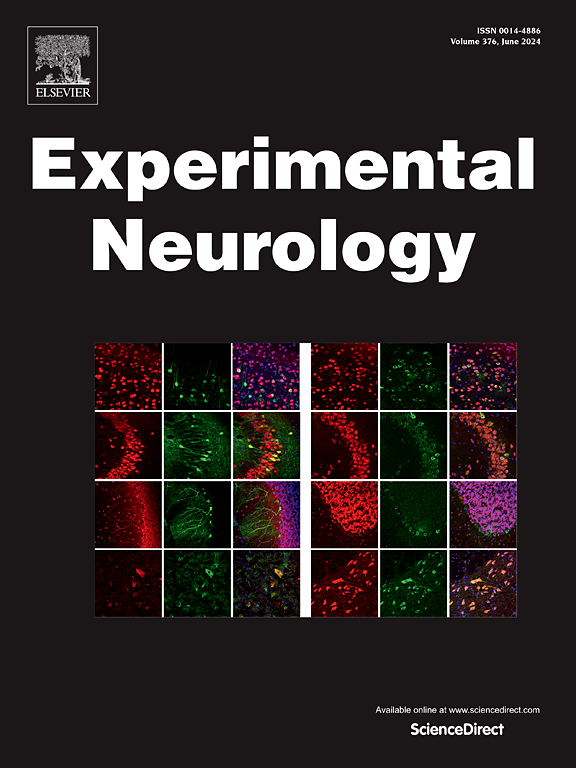Gypenoside XLIX alleviates sepsis-associated encephalopathy by targeting PPAR-α
IF 4.6
2区 医学
Q1 NEUROSCIENCES
引用次数: 0
Abstract
Sepsis-related systemic inflammation is a deadly condition with high rates of morbidity and mortality. There is evidence that sepsis affects the brain, and the most frequent organ dysfunction linked to sepsis is sepsis-associated encephalopathy. Sepsis-related brain damage can drastically reduce a patient's chances of survival. However, a specific treatment for sepsis-associated encephalopathy is not currently available. Consequently, to treat the brain damage caused by sepsis, investigating novel therapeutic strategies is imperative. After establishing the CLP-induced mouse SAE model, we treated the mice with Gyp-XLIX and evaluated apoptosis, neuroinflammation, brain damage, and oxidative stress in the brain tissue of each group of mice. Furthermore, the protective effects of Gyp-XLIX on LPS-treated BV-2 cells were assessed. We discovered that Gyp-XLIX treatment increased the survival rate of CLP-treated mice, alleviated SAE-related cerebral nerve abnormalities, and decreased blood–brain barrier breakdown, all of which could better preserve brain tissue in vivo. Furthermore, we identified associated proteins and found that Gyp-XLIX may reduce oxidative stress, cell apoptosis, and inflammation in the brain tissues of SAE mice. This observation was further validated in vitro. We established that Gyp-XLIX alleviates SAE by targeting PPAR-α. These findings may be important for the clinical applicability of Gyp-XLIX in SAE treatment. We found that Gyp-XLIX can alleviate brain injury in SAE by targeting PPAR-α and is a potential protective agent for SAE.
Gypenoside XLIX 通过靶向 PPAR-α 减轻败血症相关脑病
败血症相关的全身炎症是一种致命疾病,发病率和死亡率都很高。有证据表明,败血症会影响大脑,而与败血症有关的最常见器官功能障碍就是败血症相关性脑病。与败血症相关的脑损伤会大大降低患者的生存几率。然而,目前还没有治疗败血症相关性脑病的特效药。因此,要治疗败血症引起的脑损伤,研究新的治疗策略势在必行。在建立了 CLP 诱导的小鼠 SAE 模型后,我们用 Gyp-XLIX 对小鼠进行了治疗,并对各组小鼠脑组织中的细胞凋亡、神经炎症、脑损伤和氧化应激进行了评估。此外,还评估了 Gyp-XLIX 对经 LPS 处理的 BV-2 细胞的保护作用。我们发现,Gyp-XLIX 治疗提高了中毒性胰腺炎小鼠的存活率,缓解了与 SAE 相关的脑神经异常,并减少了血脑屏障的破坏,所有这些都能更好地保护体内脑组织。此外,我们还鉴定了相关蛋白,发现Gyp-XLIX可减少SAE小鼠脑组织中的氧化应激、细胞凋亡和炎症反应。这一观察结果在体外得到了进一步验证。我们证实,Gyp-XLIX 可通过靶向 PPAR-α 减轻 SAE。这些发现可能对 Gyp-XLIX 治疗 SAE 的临床应用具有重要意义。我们发现,Gyp-XLIX 可通过靶向 PPAR-α 减轻 SAE 的脑损伤,是一种潜在的 SAE 保护剂。
本文章由计算机程序翻译,如有差异,请以英文原文为准。
求助全文
约1分钟内获得全文
求助全文
来源期刊

Experimental Neurology
医学-神经科学
CiteScore
10.10
自引率
3.80%
发文量
258
审稿时长
42 days
期刊介绍:
Experimental Neurology, a Journal of Neuroscience Research, publishes original research in neuroscience with a particular emphasis on novel findings in neural development, regeneration, plasticity and transplantation. The journal has focused on research concerning basic mechanisms underlying neurological disorders.
 求助内容:
求助内容: 应助结果提醒方式:
应助结果提醒方式:


